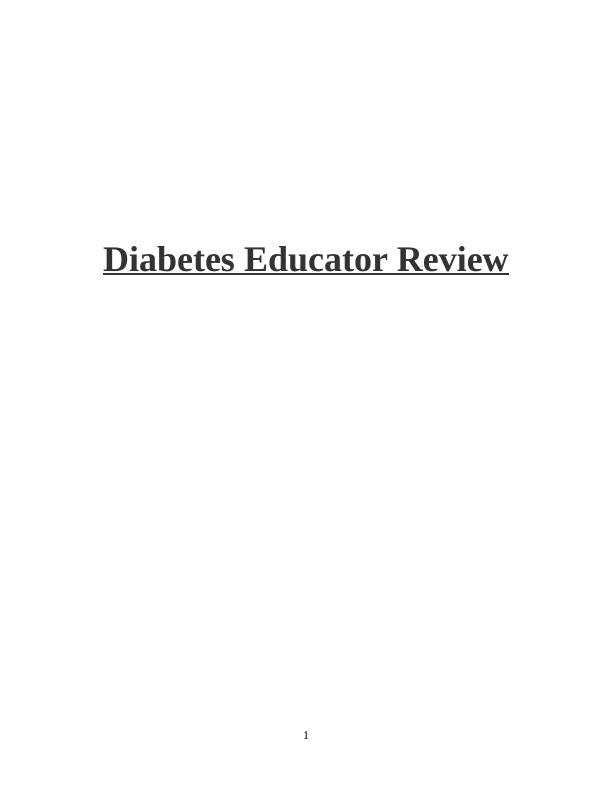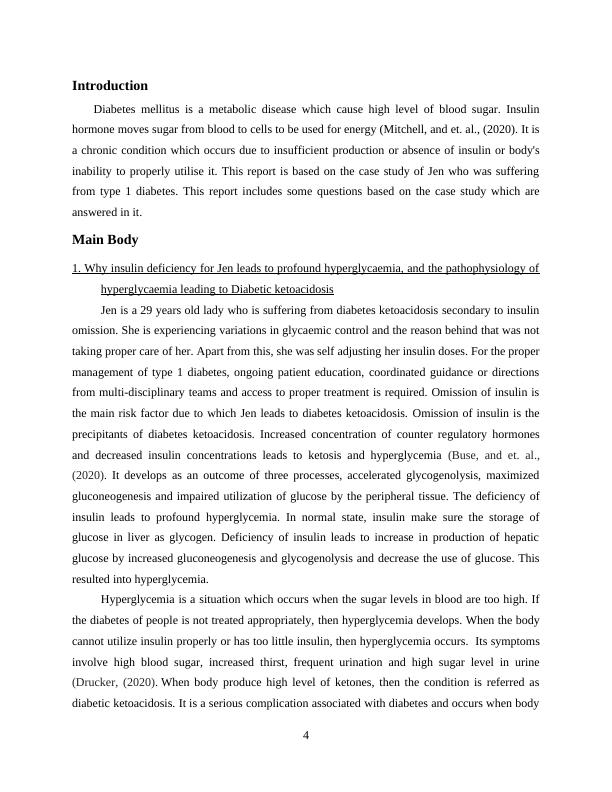Diabetes Educator Review
Added on 2023-01-06
12 Pages3451 Words40 Views
Diabetes Educator Review
1
1

2

Contents
Introduction......................................................................................................................................3
Main Body.......................................................................................................................................3
1. Why insulin deficiency for Jen leads to profound hyperglycaemia, and the pathophysiology
of hyperglycaemia leading to Diabetic ketoacidosis...................................................................3
2. Physiologic responses to hypoglycaemia and hypo-unawareness...........................................4
3. Justification of the information provided to Jen to reduce her hypoglycaemia events and
reduce hypo-unawareness in the context of her life....................................................................6
Conclusion.......................................................................................................................................7
REFERENCES................................................................................................................................8
3
Introduction......................................................................................................................................3
Main Body.......................................................................................................................................3
1. Why insulin deficiency for Jen leads to profound hyperglycaemia, and the pathophysiology
of hyperglycaemia leading to Diabetic ketoacidosis...................................................................3
2. Physiologic responses to hypoglycaemia and hypo-unawareness...........................................4
3. Justification of the information provided to Jen to reduce her hypoglycaemia events and
reduce hypo-unawareness in the context of her life....................................................................6
Conclusion.......................................................................................................................................7
REFERENCES................................................................................................................................8
3

Introduction
Diabetes mellitus is a metabolic disease which cause high level of blood sugar. Insulin
hormone moves sugar from blood to cells to be used for energy (Mitchell, and et. al., (2020). It is
a chronic condition which occurs due to insufficient production or absence of insulin or body's
inability to properly utilise it. This report is based on the case study of Jen who was suffering
from type 1 diabetes. This report includes some questions based on the case study which are
answered in it.
Main Body
1. Why insulin deficiency for Jen leads to profound hyperglycaemia, and the pathophysiology of
hyperglycaemia leading to Diabetic ketoacidosis
Jen is a 29 years old lady who is suffering from diabetes ketoacidosis secondary to insulin
omission. She is experiencing variations in glycaemic control and the reason behind that was not
taking proper care of her. Apart from this, she was self adjusting her insulin doses. For the proper
management of type 1 diabetes, ongoing patient education, coordinated guidance or directions
from multi-disciplinary teams and access to proper treatment is required. Omission of insulin is
the main risk factor due to which Jen leads to diabetes ketoacidosis. Omission of insulin is the
precipitants of diabetes ketoacidosis. Increased concentration of counter regulatory hormones
and decreased insulin concentrations leads to ketosis and hyperglycemia (Buse, and et. al.,
(2020). It develops as an outcome of three processes, accelerated glycogenolysis, maximized
gluconeogenesis and impaired utilization of glucose by the peripheral tissue. The deficiency of
insulin leads to profound hyperglycemia. In normal state, insulin make sure the storage of
glucose in liver as glycogen. Deficiency of insulin leads to increase in production of hepatic
glucose by increased gluconeogenesis and glycogenolysis and decrease the use of glucose. This
resulted into hyperglycemia.
Hyperglycemia is a situation which occurs when the sugar levels in blood are too high. If
the diabetes of people is not treated appropriately, then hyperglycemia develops. When the body
cannot utilize insulin properly or has too little insulin, then hyperglycemia occurs. Its symptoms
involve high blood sugar, increased thirst, frequent urination and high sugar level in urine
(Drucker, (2020). When body produce high level of ketones, then the condition is referred as
diabetic ketoacidosis. It is a serious complication associated with diabetes and occurs when body
4
Diabetes mellitus is a metabolic disease which cause high level of blood sugar. Insulin
hormone moves sugar from blood to cells to be used for energy (Mitchell, and et. al., (2020). It is
a chronic condition which occurs due to insufficient production or absence of insulin or body's
inability to properly utilise it. This report is based on the case study of Jen who was suffering
from type 1 diabetes. This report includes some questions based on the case study which are
answered in it.
Main Body
1. Why insulin deficiency for Jen leads to profound hyperglycaemia, and the pathophysiology of
hyperglycaemia leading to Diabetic ketoacidosis
Jen is a 29 years old lady who is suffering from diabetes ketoacidosis secondary to insulin
omission. She is experiencing variations in glycaemic control and the reason behind that was not
taking proper care of her. Apart from this, she was self adjusting her insulin doses. For the proper
management of type 1 diabetes, ongoing patient education, coordinated guidance or directions
from multi-disciplinary teams and access to proper treatment is required. Omission of insulin is
the main risk factor due to which Jen leads to diabetes ketoacidosis. Omission of insulin is the
precipitants of diabetes ketoacidosis. Increased concentration of counter regulatory hormones
and decreased insulin concentrations leads to ketosis and hyperglycemia (Buse, and et. al.,
(2020). It develops as an outcome of three processes, accelerated glycogenolysis, maximized
gluconeogenesis and impaired utilization of glucose by the peripheral tissue. The deficiency of
insulin leads to profound hyperglycemia. In normal state, insulin make sure the storage of
glucose in liver as glycogen. Deficiency of insulin leads to increase in production of hepatic
glucose by increased gluconeogenesis and glycogenolysis and decrease the use of glucose. This
resulted into hyperglycemia.
Hyperglycemia is a situation which occurs when the sugar levels in blood are too high. If
the diabetes of people is not treated appropriately, then hyperglycemia develops. When the body
cannot utilize insulin properly or has too little insulin, then hyperglycemia occurs. Its symptoms
involve high blood sugar, increased thirst, frequent urination and high sugar level in urine
(Drucker, (2020). When body produce high level of ketones, then the condition is referred as
diabetic ketoacidosis. It is a serious complication associated with diabetes and occurs when body
4

End of preview
Want to access all the pages? Upload your documents or become a member.
Related Documents
Pathophysiology of Diabetic Ketoacidosislg...
|16
|3646
|65
Question | Insulin is a kind of hormone which is produced from pancreas inside the human body.lg...
|7
|1495
|11
Nursing Intervention.lg...
|13
|2543
|2
Applied Pathophysiology Assignment Reportlg...
|10
|2490
|13
Nursing Assignment: Diabetes Mellitus Case Studylg...
|9
|1531
|49
Function of Synthesis of Insulin - MELS230lg...
|6
|2220
|58
